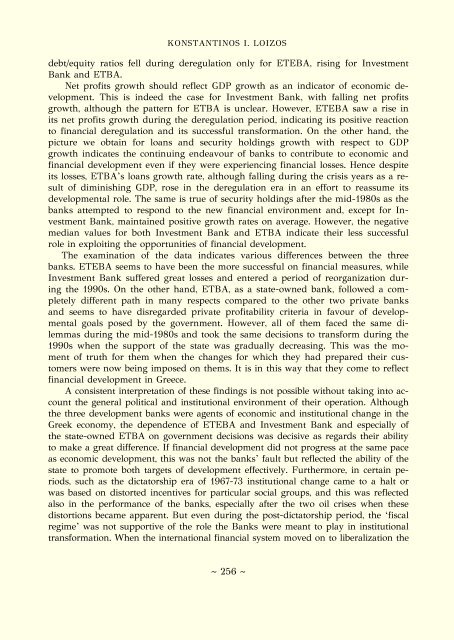Create successful ePaper yourself
Turn your PDF publications into a flip-book with our unique Google optimized e-Paper software.
KONSTANTINOS I. LOIZOS<br />
debt/equity ratios fell during deregulation only for ETEBA, rising for Investment<br />
Bank and ETBA.<br />
Net profits growth should reflect GDP growth as an indicator of economic development.<br />
This is indeed the case for Investment Bank, with falling net profits<br />
growth, although the pattern for ETBA is unclear. However, ETEBA saw a rise in<br />
its net profits growth during the deregulation period, indicating its positive reaction<br />
to financial deregulation and its successful transformation. On the other hand, the<br />
picture we obtain for loans and security holdings growth with respect to GDP<br />
growth indicates the continuing endeavour of banks to contribute to economic and<br />
financial development even if they were experiencing financial losses. Hence despite<br />
its losses, ETBA’s loans growth rate, although falling during the crisis years as a result<br />
of diminishing GDP, rose in the deregulation era in an effort to reassume its<br />
developmental role. The same is true of security holdings after the mid-1980s as the<br />
banks attempted to respond to the new financial environment and, except for Investment<br />
Bank, maintained positive growth rates on average. However, the negative<br />
median values for both Investment Bank and ETBA indicate their less successful<br />
role in exploiting the opportunities of financial development.<br />
The examination of the data indicates various differences between the three<br />
banks. ETEBA seems to have been the more successful on financial measures, while<br />
Investment Bank suffered great losses and entered a period of reorganization during<br />
the 1990s. On the other hand, ETBA, as a state-owned bank, followed a completely<br />
different path in many respects compared to the other two private banks<br />
and seems to have disregarded private profitability criteria in favour of developmental<br />
goals posed by the government. However, all of them faced the same dilemmas<br />
during the mid-1980s and took the same decisions to transform during the<br />
1990s when the support of the state was gradually decreasing. This was the moment<br />
of truth for them when the changes for which they had prepared their customers<br />
were now being imposed on thems. It is in this way that they come to reflect<br />
financial development in Greece.<br />
A consistent interpretation of these findings is not possible without taking into account<br />
the general political and institutional environment of their operation. Although<br />
the three development banks were agents of economic and institutional change in the<br />
Greek economy, the dependence of ETEBA and Investment Bank and especially of<br />
the state-owned ETBA on government decisions was decisive as regards their ability<br />
to make a great difference. If financial development did not progress at the same pace<br />
as economic development, this was not the banks’ fault but reflected the ability of the<br />
state to promote both targets of development effectively. Furthermore, in certain periods,<br />
such as the dictatorship era of 1967-73 institutional change came to a halt or<br />
was based on distorted incentives for particular social groups, and this was reflected<br />
also in the performance of the banks, especially after the two oil crises when these<br />
distortions became apparent. But even during the post-dictatorship period, the ‘fiscal<br />
regime’ was not supportive of the role the Banks were meant to play in institutional<br />
transformation. When the international financial system moved on to liberalization the<br />
~ 256 ~



